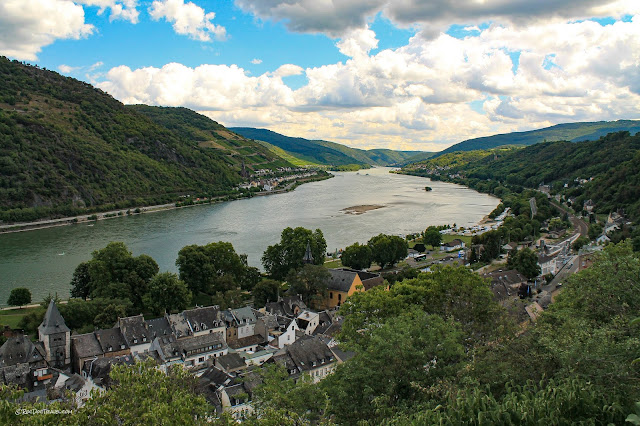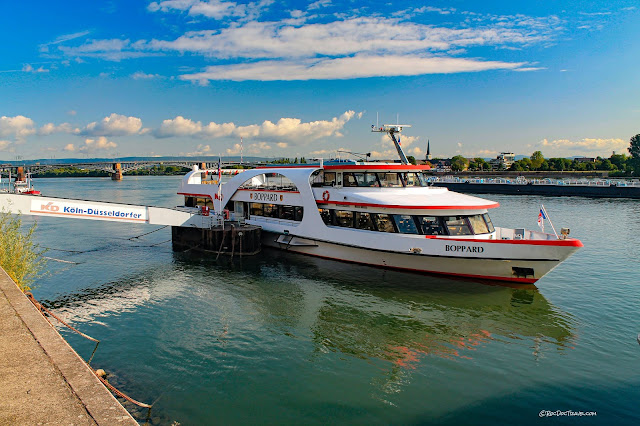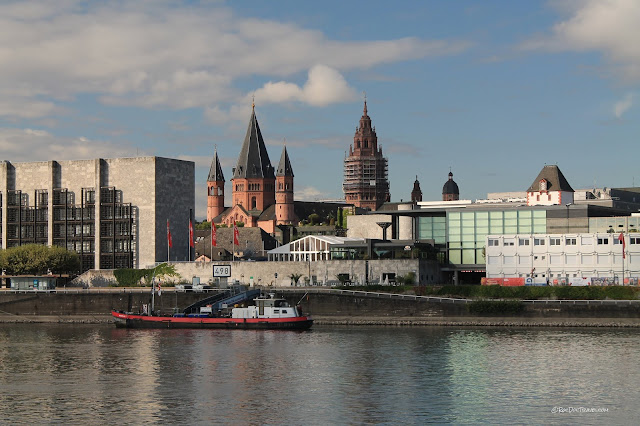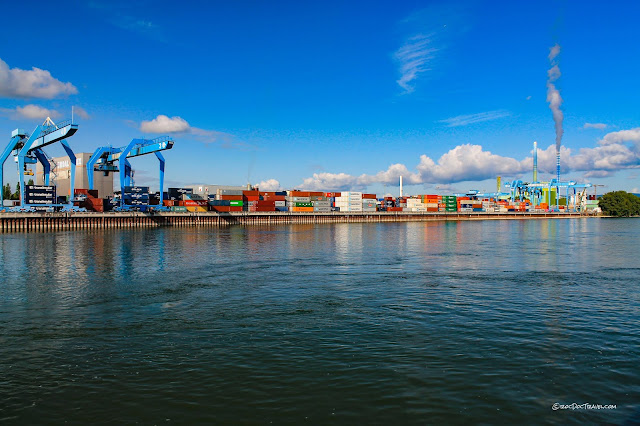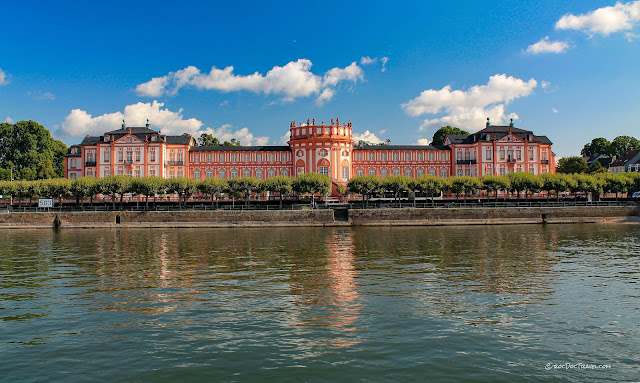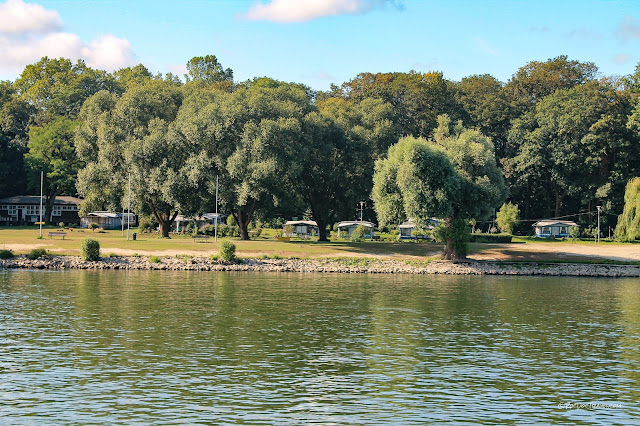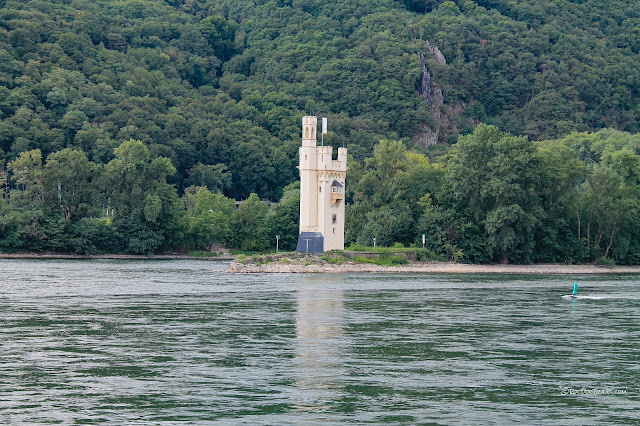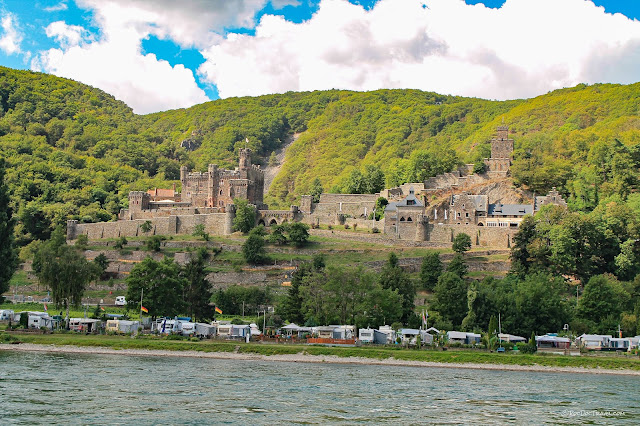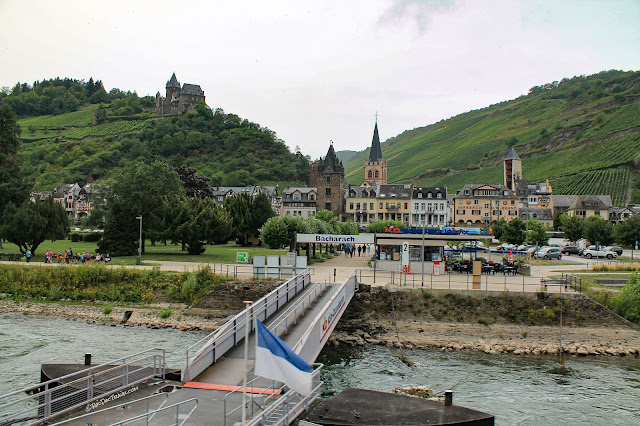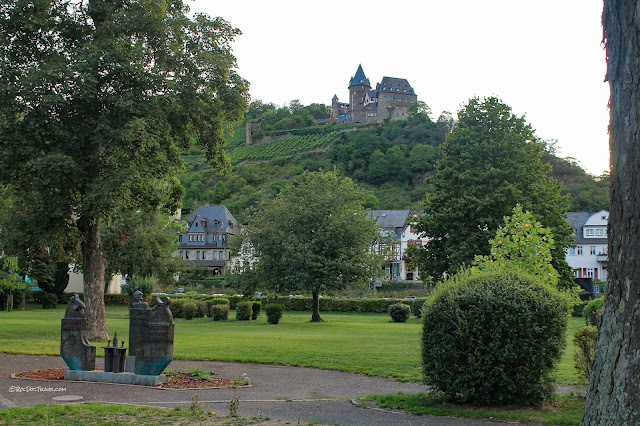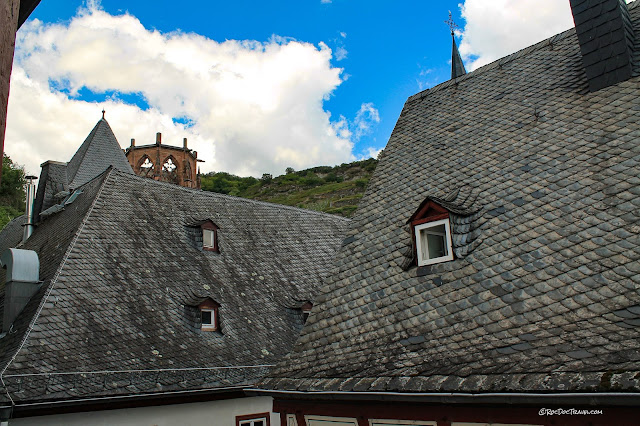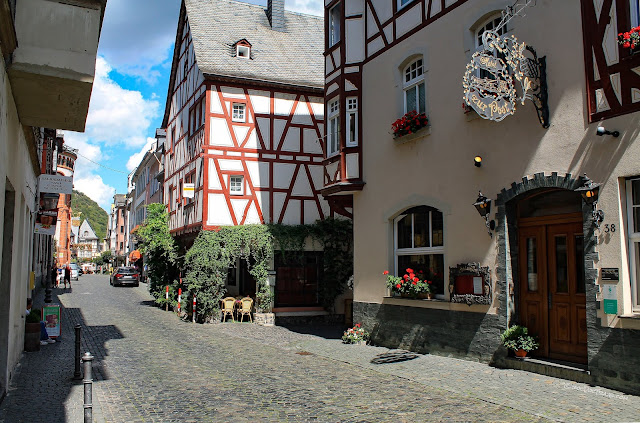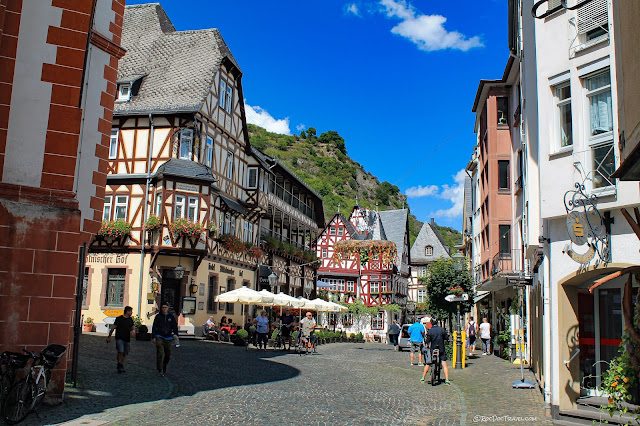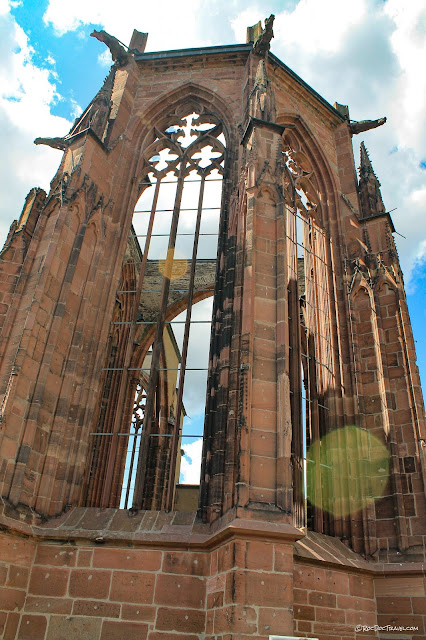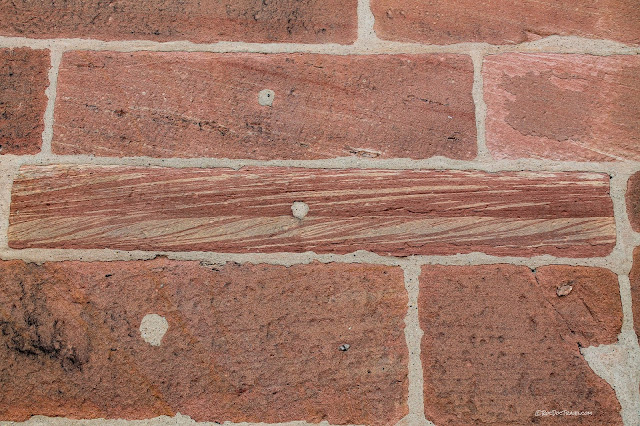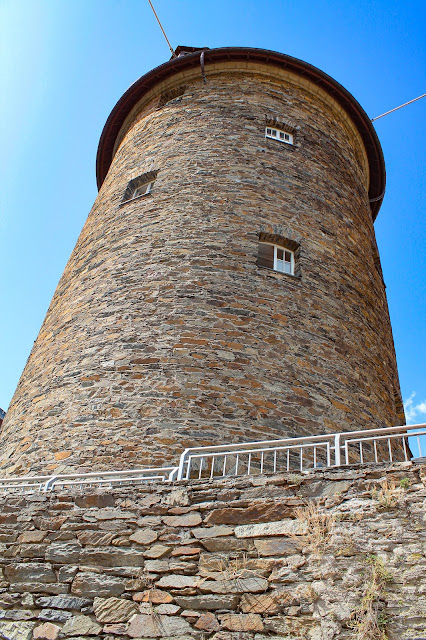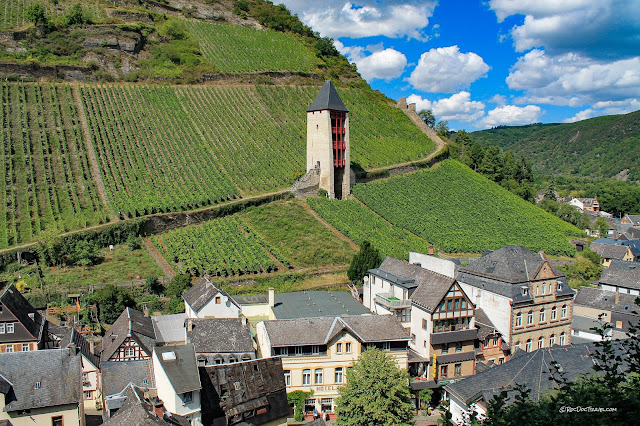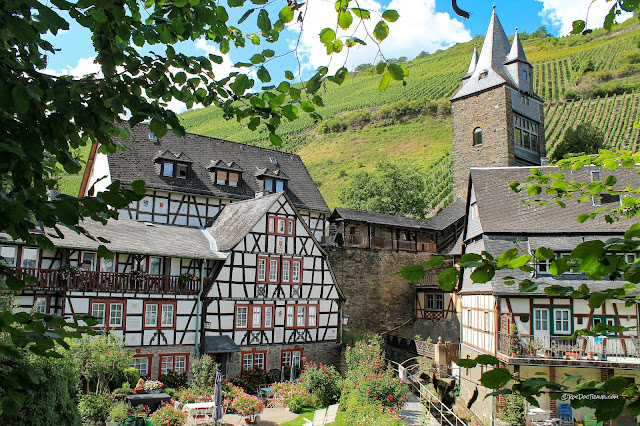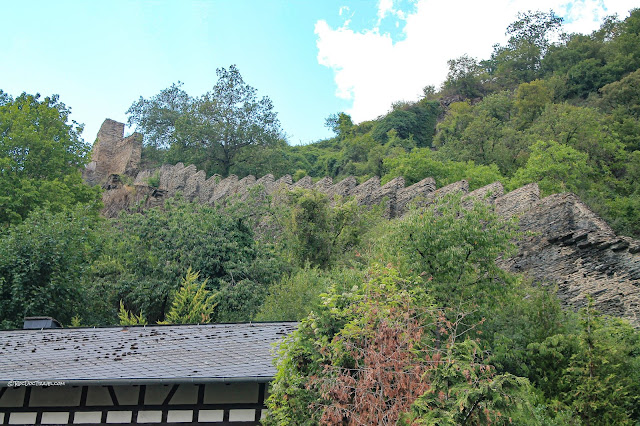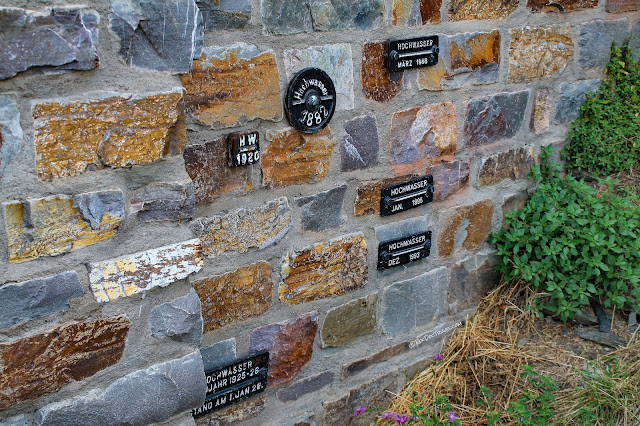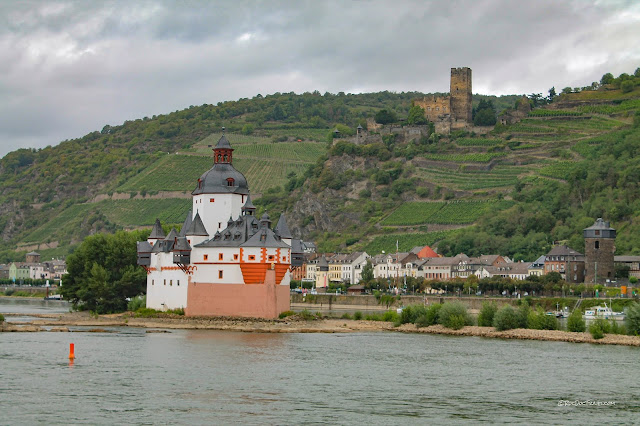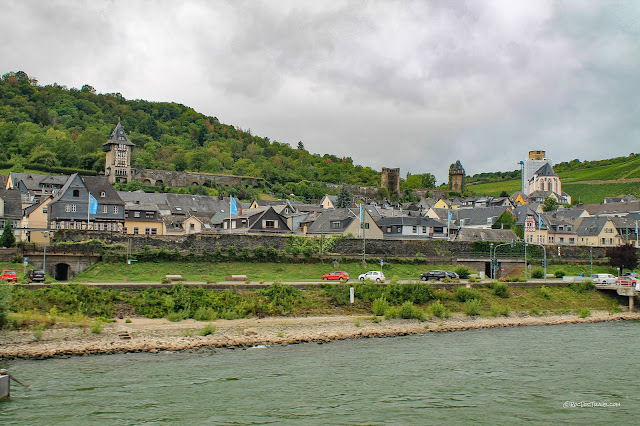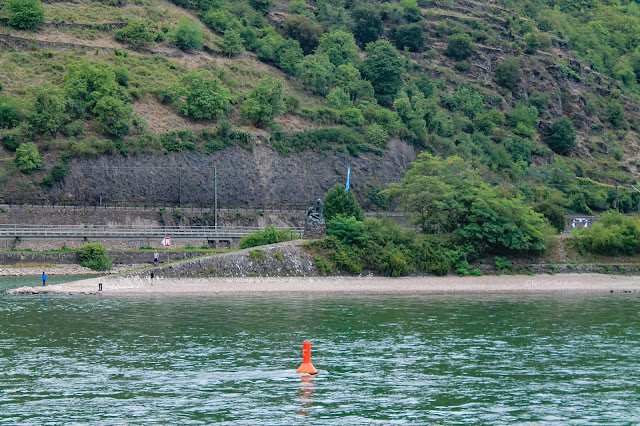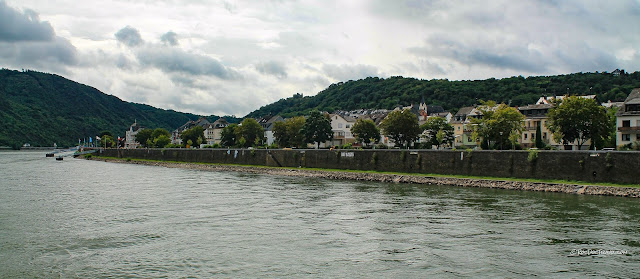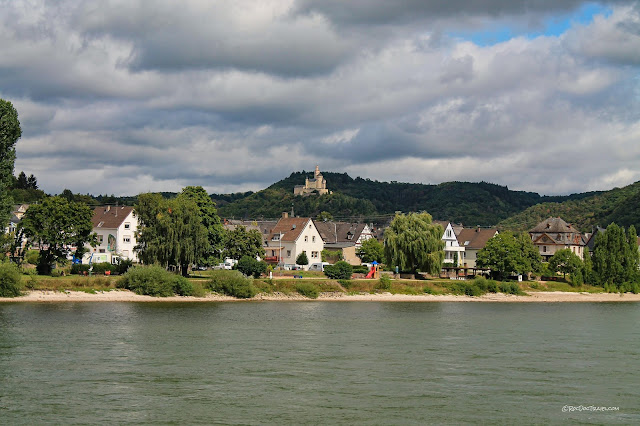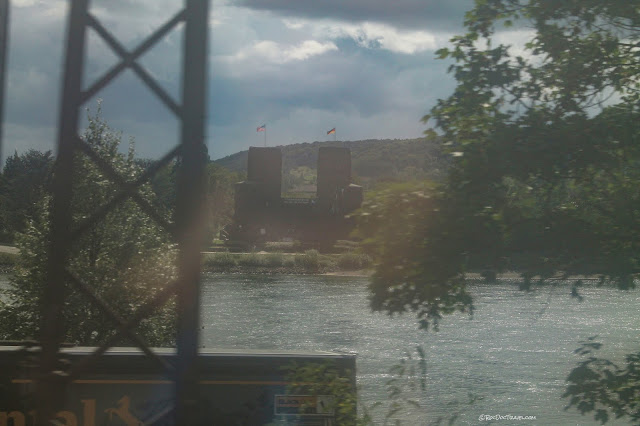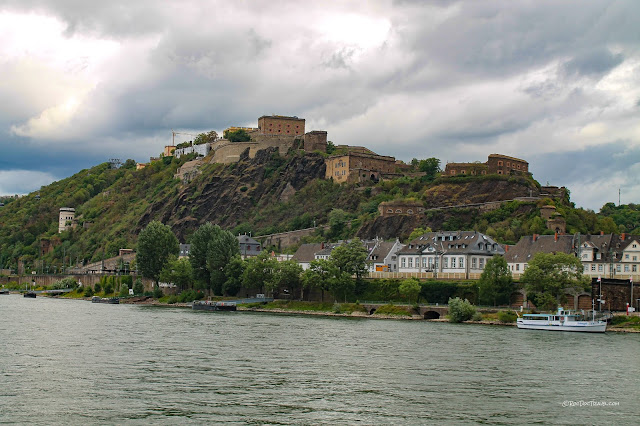Rhine River, Germany
Take a geologic boat trip down Germany's Romantic Rhine River
Cruise by castles from Mainz to Koblenz in this UNESCO World Heritage area!This cruise can be done in either direction. As shown here, we start in Mainz (near Frankfurt) and go north to Koblenz.
Travel to the Rhine River
Interactive Google Map of Mainz, Germany. You can zoom and move.
Cruise Line Website: https://www.k-d.com/en/
You can get on and off all along the route. Plan on at least two days -- more if you have time. I recommend staying overnight at Bacharach.
What You'll See: The stretch from Mainz to Koblenz, the Middle Rhine, is also called the "Romantic Rhine" because of its peaceful scenery, charming villages, and amazing array of castles right along the river. Because of its important history, it is also a UNESCO World Heritage Area.
Geologically, the river cuts across an uplift with some of Germany's older rocks. The Devonian (about 360 to 400 million years old) quartzite and slate is steeply tilted, and provides the distinctive dark brown to gray roof tiles and building materials used throughout this part of Germany.
More Information: Rick Steves has an excellent guide for travel on the Romantic Rhine: https://www.ricksteves.com/watch-read-listen/video/tv-show/germanys-romantic-rhine-and-rothenburg
Mainz to Rudesheim
We chose the K-D Lines for this trip because of their good reviews and affordable prices. The boat has food available, but to save money you might consider packing lunches. Ride on the top deck to best enjoy the views.
We flew into Frankfurt, spent a day looking around that wonderful city, and stayed in Mainz. It's a surprisingly interesting, scenic, historic, uncrowded and very German city! The big church in this picture is the Mainzer Dom, which dates to the 900's. It's made of local sandstone. Right next to it is an excessively charming town market square.
This is the baroque Biebrich Palace in Wiesbaden, built in 1703 and home to dukes and princes of Nassau until 1841. It's now offices and conference facilities for the state of Hess.
The beautiful river banks naturally have a good number of beautiful homes, but they're not as over-developed as so many American rivers are. It's all just peaceful and lovely.
The white tower is the Electoral Tower in Eltville, built in 1350. The pink sandstone church beyond is the Parish Church of Saints Peter and Paul, which also dates back to the 1300's.
The Rudesheim area is very popular with German vacationers because of its charm, scenery, and history.
Bingen to Bacharach
Where the river enters the canyon at Bingen, of course there are two castle structures guarding the passage, Mouse Tower on the left and Ehrenfels castle on the right. Most of the Middle Rhine castles were built by what we would call "robber-barons" during the centuries when the region was a collection of independent territories, who extorted money from cargo shippers on the river.
The site of Mouse Tower served as a signal or customs tower from Roman times. After being destroyed several times, the current structure was built in 1855.
Ehrenfels Castle was built in about 1212 as defense in one of many regional conflicts. It was ruined by the French army in 1689, along with most castles along the Middle Rhine.
Look how this castle takes advantage of natural cliff defenses! This is Rheinstein Castle, first built in 1316, and is currently a hotel. The cliffs are quartzite and slate standing vertically.
The old and the new -- the big Reichenstein Castle, built in the 1200's, stands above modern campsites. Like many in Germany, the castle was rebuilt in the late 1800's. Note how this and all the castles are made of local stone, which helps them blend into the hillsides beautifully.
Sooneck Castle was also built in the 1200's by robber barons, and was restored in the late 1800's.
Bacharach
Bacharach is the most charming town! It dates back over a thousand years, and was one of the region's most important cities in the Middle Ages. Bacharach was important in the regional wine trade. It was also involved in the region's long history of wars, and was at times occupied by the French, Spanish, and Swedish.
The town is overlooked by the Stahleck Castle, first built in the 1100's and, of course, destroyed and rebuilt several times since.
We stayed in the centuries-old Hotel Zur Post. It was completely wonderful!
Keep your camera handy in Bacharach! You could stand anywhere in town and get a great picture. The timber-frame houses are as old as 700 years. The vine-covered restaurant is wonderful Rusticana.
The middle of Bacharach, Germany.
The Gothic Werner Chapel (Wernerkapelle) sitting above Bacharach was begun in 1287, but not completed until about 1438. Along with Stahleck Castle, it was destroyed in 1689. The chapel has a gruesome connection to history -- the murder of its namesake (just a boy) was a trigger to a pogrom in which the region's Jews were massacred.
The pinkish sandstone used so much in this region has cross-bedding formed by the slow movement of sediments by flowing water.
The roofless, windowless chapel is used for weddings.
Bacharach is at a gentle bend in the Rhine.
The Rhine at low flow has many obstacles -- sand bars and erosion control jetties.
Stahleck Castle on the hill above Bacharach is a youth hostel, and hosts school field trips. The oldest walls date back to the 1100's, and the youngest to the rebuilding in the 1920's in which original walls and rock were used as much as possible. It was a youth hostel from the beginning.
The tower or keep was reconstructed in the 1960's.
The tower building, the original girls' dormitory. During World War II, the castle was used as a military hospital and youth re-education prison.
The castle is part of a 14th century wall and tower system, with six surviving towers (or parts thereof). This one is called the Postenturm, and has a terrific view of the town at the top of its stairs. Admission is free.
Altes Haus dates from 1389, and has well preserved features typical of the 14th century. The ground floor houses an excellent restaurant.
Bacharach is protected by this 14th century wall that completely encircles the town.
These flood markers are located at the main pedestrian passage under the railroad. They represent mighty impressive floods on this huge river! The deepest flood occurred in 1850 because of an ice jam downstream at the Lorelei narrows, and was well above all of these, up several feet into the center of town.
A look back at Bacharach from the river. Whew! I made it this far without mentioning Burt!
Bacharach to Koblenz
You'll pass countless barges on the busy Rhine.
Unique Pfalzgrafenstein Castle (link) is on a bedrock island in the river near Kaub. Built in 1327, it was a toll collection station, one of twelve between Mainz and Koln. This station deviously raised a huge chain across the river to force ships to stop. It worked in conjunction with Gutenfels Castle on the hill. At the time it operated, the river channel on the left (west) side was impassable, and all ships had to pass through the narrow channel on the right (east) bank. The west channel was widened in the 1800's.
The beautiful town of Oberwesel is popular with tourists.
These nets catch falling rocks to protect the road and buildings.
This is the Lorelei narrows, where a siren (according to a story and a poem) sat on the cliffs above (right side of the photo), singing and combing her golden hair to distract boaters from the rocky hazards in the river. The reality is that the hard bedrock here forms treacherous shoals that have sunk many a boat.
The Burg Katz is just downstream from the Lorelei narrows. It was built in 1371 and rebuilt in the 1890's. It is privately owned, and not open to the public.
This is the popular Rheinfels Castle (link) above St. Goar, biggest castle on the Rhine. Started in 1245, it was expanded over the centuries until it was destroyed by French troops in 1797. It is largely in ruins now, but is a highly recommended site.
The flood wall at Bad Salzig ("bad" means bath, usually meaning springs) shows the possible floodwater levels at this location. Old towns have long-term experience with their rivers that young towns don't have, so that they know just how high a river can get.
Beautiful Marksburg Castle is on the hills above Braubach.
Marksburg Castle (link) was a fortress first built in the 1100's to defend Braubach and enforce river tolls. It was damaged by American artillery fire from across the Rhine in 1945.
Solzenfels Castle (link) was first built in 1259 to extort tolls on the river, and extended several times until it was destroyed by the French in 1689. It was rebuilt in the 1840's.
Ludendorff Bridge, Remagen
These towers are the remains of the infamous Ludendorff Bridge at Remagen. In Spring of 1945, the American 9th Armored Division advanced here rapidly. The German attempt to blow up the bridge failed, allowing the Americans to cross the Rhine and disrupt German efforts to regroup. The German air attacks on the bridge over the next 10 days are called the largest anti-aircraft battle in history, with over 360 aircraft involved, 30% of which were shot down. Capture of the "Remagen Bridge" was a turning point in the war, allowing 5 American divisions to cross the river into Germany's industrial heart. Badly damaged, the bridge finally collapsed, but not before the Army engineers were able to construct two temporary bridges nearby.A memorial plaque at the bridge states: "THIS TIME IN PEACE. In March of 1945, two mighty armies met here in battle. In October of 1991, they met here again, this time in peace and friendship. LEST WE FORGET."
Trivia: The bridge is mentioned in "It's a Wonderful Life," recounting how Mary's brother Marty helped capture "the Remagen Bridge."
The mighty Ehrenbreitstein Fortress at Koblenz (link) watches over the confluence with the Moselle River. It was built on the site of earlier fortresses in 1828 to defend against the French, but was never attacked by them. The site on hard, durable Devonian slates and quartzites has been occupied since the fourth millennium B.C.
5 Cool Sites in Germany
Rothenburg ob der Tauber, Germany
Some of Germany's Best Fossils
Matterhorn
Lauterbrunnen Valley, Switzerland
Aletsch Glacier
Glarus Thrust, Alps
M.S. -- More Science
Geologic Map of Germany
x
